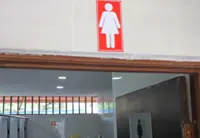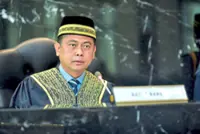Passengers boarding a GoKL bus at the Hab Titiwangsa stop, Kuala Lumpur.
Since Jan 1, Kuala Lumpur City Hall (DBKL) has been trialling articulated buses on four GoKL routes, aiming to enhance the city’s public transport system by offering increased passenger capacity and reduced wait times.
These bendy buses, featuring two carriages connected by flexible sections, promise improved manoeuvrability and efficiency.
However, their introduction raises concerns about potential road reconfigurations needed across the city.
The trial, set to conclude on April 30, dedicates one month to each selected route: GoKL 01, GoKL 03, GoKL 08, and GoKL 10.
According to public transport users and experts interviewed by StarMetro, while these buses offer greater capacity and shorter wait times, adjustments to road infrastructure may be necessary to accommodate them.
In a statement, DBKL said users’ feedback on articulated buses throughout the two-month trial period have been positive.
“So far, there is no issue about the selected routes. The official results of the trial will be announced after it ends in April.
“The usage of articulated buses after the trial period depends on their feasibility which will also be determined by the results of the trial run,” it added.
DBKL also said it has widened the road at some junctions to ensure the smooth operations of articulated buses, which have a capacity for up to 165 passengers (24 sitting and 141 standing).
However, StarMetro did not manage to hop on the articulated buses despite waiting for almost two hours at the HAB Titiwangsa bus stop, which is one of the stops in the GoKL 03 route involved in the trial last month. (Trial run for the route ended in February).
According to an announcement by DBKL on social media last month, the frequency of articulated buses during the trial period was one bus per hour during peak hours and one bus every 90 minutes during non-peak hours.
However, responding to complaints about longer waiting time, DBKL said “the current waiting time for articulated buses is between one hour to two hours and a half, depending on the buses’ distance from the stops and traffic condition.
“The schedule for articulated buses may be slightly disturbed by the traffic factor, considering it is still under the trial period.
“Nevertheless, users can still use other GoKL buses as an alternative or refer to the GoKL app to obtain live information on the buses’ arrival,” it said.
DBKL added that it was committed to improving the quality of GoKL’s service as well as collaborating with Prasarana Malaysia Bhd or RapidKL to build a more comprehensive and accessible public transport network for Kuala Lumpur folk.
Road reconfigurations
Zac Cheong, the vice-secretary for Transit Malaysia, a non- governmental organisation that advocates for better public transport, said loading spots, parking and lanes for buses would need reconfiguring to accommodate the articulated buses as they have greater length, size and turning radius.
“Existing bus stops may need to be extended to provide enough space for articulated buses to park when allowing passengers to board and disembark safely.
“In congested areas, the dedicated bus lanes may need to be widened to ensure these buses can pass through without obstructing traffic on other lanes,” he said.
Although road reconfiguration could cause short-term traffic congestion, Cheong believes the use of articulated buses could reduce congestion by decreasing the number of buses on the roads while maintaining or improving passenger capacity.
“Though the effect won’t be immediate, people will eventually consider switching to buses if it means faster access and less stress driving into the city,” he said.
Meanwhile, Afiq Daniel, vocal on social media about public transport issues, suggested widening slip lanes at junctions as articulated buses generally have more difficulty turning left than right.
“It is possible for articulated buses to encroach on the opposite lane while turning left. Hence, the slip lane would need to be widened,” he said.
He noted that articulated buses might have difficulty using lay-bys, and could be forced to stop on the road since many Malaysian bus stops aren’t suited even for conventional buses.
Articulated vs double-decker
Cheong said articulated buses are easier to board compared to double-decker buses.
“Being a single-deck bus, an articulated bus can also benefit people with disabilities and senior citizens.
“It can carry significantly more passengers, reducing overcrowding and increasing the efficiency of public transport,” he added.
Afiq said articulated buses can also help reduce the passengers’ waiting time at bus stops.
Articulated buses, he added were essentially “MRT on the roads” due to having more doors than conventional buses.
“Conventional buses only have one door for boarding, making the dwell time at bus stops quite long.
“Currently, only the double-decker buses can match the capacity of articulated buses, but the wait time of double-decker buses is significantly longer as the passengers need time to navigate the stairs to reach the only door for boarding and disembarking on the buses.
“With more doors, articulated buses are more accessible compared to double-decker buses.
“For bus routes where passengers are only moving between three and seven stops on average, articulated buses are better than double-decker buses,” he said.
Call for improvements
Cheong suggested expanding bus services – articulated or otherwise – to more areas, especially underserved regions.
Areas on the outskirts of Kuala Lumpur, such as Kepong and Cheras, may not have as many bus services as areas nearer the city centre.
“In areas where they are available, services tend to be irregular or not well-connected to key transport hubs.
“High-density areas with limited direct connections to public transport, such as Desa Park City and Bangsar South, may face challenges with bus frequency and coverage, despite being in growing and developed parts of the city,” he said.
Cheong also called for the GoKL app to be improved by integrating it with other public transport services.
“There should be one super app for public transport in the Klang Valley and not a myriad of apps as it is now.
“Improved connections and better integration between buses and other modes of public transport like LRT, KTM Komuter, monorail and MRT could make commuting easier and more efficient,” he added.
Afiq said although articulated buses could help address the overcrowding issue currently impacting GoKL buses, it would not attract many new riders.
“The only way to fix this is to increase the buses’ frequency and expand their service to 24/7.
“DBKL can also consider running both conventional and articulated buses together to increase their capacity,” he added.
He also called for a redesign of Kuala Lumpur’s bus network to provide more single transit and cross-city routes to reduce the passengers’ hassle of switching buses.
There is also a dire need to increase the number of buses –whether articulated or conventional – in the city, said transport consultant Ernest Wong.
“Kuala Lumpur currently has about 1,500 buses, although it is estimated that around 7,000 buses are needed to serve the city,” he said.
Wong also called for consistent bus timings that would not vary drastically between peak and off-peak hours.










